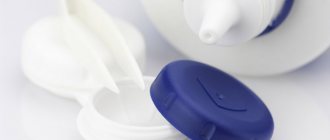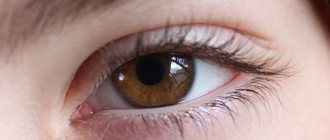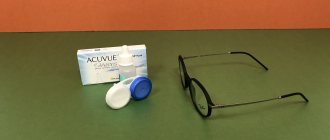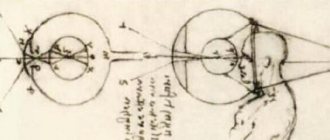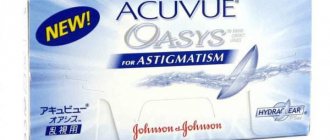Diseases
The first reason for refusing to use optics is pathologies of the visual organ that affect the cornea and conjunctiva. Doctors also identify a number of diseases that prohibit wearing contact lenses, and give explanations for this prohibition.
Conjunctivitis
It is unsafe to use CL for this disease. After a few days, the person will feel itching and watery eyes. The mucous membrane of the eye turns red, and the lens itself becomes a carrier of bacteria and viruses. CL will prevent conjunctivitis from healing.
Therefore, this medical accessory should be excluded during therapy.
Keratitis
Keratitis can develop as a result of lens use. The development of a microbial disease prohibits further use of contact optics.
Blepharitis
When the meibomian glands become inflamed, there is a high risk of infection getting onto the lens and through it into the cornea. This may result in vision impairment. Therefore, the use of CL for blepharitis is highly discouraged.
Lens subluxation
Severe cases of ophthalmic ectopia are accompanied by inflammatory processes. In such a situation, the doctor is forced to prohibit the patient from using contact correction devices.
Continuing to use CL, the situation will worsen, inflammation will progress regardless of treatment tactics.
Strabismus
It is an absolute contraindication to the use of CL. Visual pathology is not corrected by them. They only restore clarity of vision. Strabismus itself cannot be cured. But refractive errors can be corrected.
Infectious diseases
They impose a ban on CL. Contact optics will become a carrier of bacteria, spreading the infection further.
Allergy
Allergic inflammatory processes also impose restrictions on the use of contact optics. The allergy will worsen.
Sinusitis
Sinusitis of various stages is accompanied by a decrease in the immune system and impaired outflow of fluid through the tear ducts. The use of optics will aggravate the condition and may provoke the development of other visual pathologies.
Cold
Colds cause complications in the eyes. It is recommended to switch to glasses. A runny nose disrupts the normal outflow of tear fluid, which will lead to the development of dry eye syndrome.
This is just a small list of pathological conditions in which wearing contact optics is contraindicated. The list of prohibitions is much wider. Tear duct obstruction, xerophthalmia, myasthenia gravis, glaucoma and influenza also fall on this list.
If it is not possible to refuse contact lenses during treatment, you will have to take 2 times better care of your eye health and care of products. Disinfect using a peroxide system 2 times a week, do not forget about mechanical cleaning.
What diseases prevent the use of CL?
No matter how perfect contact optics is, it cannot help in many life situations. To eliminate the undesirable consequences of its incorrect use, you need to consult an ophthalmologist or a specialist who deals specifically with CL - a contact specialist. Individual diagnostics can identify visual impairment after an illness. A permanent or temporary ban on this type of correction helps to avoid various complications. First of all, this applies to any eye diseases affecting the conjunctiva, as well as the outer membrane. A taboo on wearing CL is imposed for the following complications:
- chronic form of visual allergy;
- severe diabetes mellitus;
- inflammatory processes in the body;
- chronic tuberculosis;
- hyperthyroidism,
- mental illness of any degree, as well as diseases of the central nervous system;
- ARVI;
- HIV infection;
- chronic inflammation of the lungs and bronchi;
- the body's predisposition to infectious, bacterial contamination;
- keratitis (inflammation or disruption of the top layer of the cornea);
- iritis, iridocyclitis - acute inflammatory processes in the anterior part of the choroid of the organs of vision;
- dryness of the conjunctiva and cornea of the eye (xerophthalmia), including those caused by taking hormonal and oral contraceptives;
- strabismus or strabismus with an excess of the angle of curvature of more than 15 degrees;
- blepharitis: a whole group of difficult-to-treat diseases that cause inflammation of the edges of the eyelids;
- obstruction of the lacrimal ducts;
- abnormal position (drooping) of the upper eyelid – ptosis;
- changes in the composition of tear fluid;
- subluxation of the lens;
- conjunctivitis of an infectious or allergic nature.
Attention! If your body is intolerant to pollen from flowering plants, it is better to use disposable lenses.
It is allowed to wear contact optics with high oxygen permeability to diabetics in a mild stage of the disease. Due to their reduced immunity, they are required to regularly visit a doctor to reduce the risk of contracting conjunctivitis or keratitis. In addition, the sensitivity of the horny tissue decreases, and the risk of causing microtrauma during removal or donning of CLs increases.
The list of professions where there are contraindications for contact lenses includes:
- miners, builders, other professions associated with heavy physical activity;
- railway transport workers;
- military personnel;
- firefighters;
- divers;
- employees of the Ministry of Emergency Situations;
- police officers.
Taking medications
Wearing contact vision correction devices is prohibited when using certain medications. It is recommended to refuse lenses if the patient is taking diuretics, including folk infusions and decoctions.
Their action is based on the removal of fluid from the body, which can also dry out the mucous membranes and skin. Therefore, wearing optics will cause dryness. It will be difficult to use CL. Moisturizing drops or lubricants may be prescribed.
But most doctors ban the use of lenses.
Contact optics are prohibited when using antihistamines. You cannot simultaneously use medications to treat a runny nose or medications for motion sickness while wearing a CL. These drugs cause blurred vision.
Oral contraceptives cause intolerance to medical lenses; this is important to consider before starting medication.
Temporary ban on wearing lenses
There are situations when you need to stop using contact optics for a certain period. A striking example is the proliferation of blood vessels from prolonged wearing of hydrogel glasses. Due to insufficient access to the eye tissues of oxygen, various pathologies develop. The vessels of the cornea, fighting hypoxia, change, growing into it, although not deeply. In this case, it is better to abandon CL until visual function is completely restored.
Allergic rhinitis. Characterized by seasonal nature. It is expressed in a painful reaction of the body to plant pollen: burning, itching in the eyes, short-term decrease in visual acuity, increased lacrimation. Manifests itself as acute inflammation of the mucous membranes (conjunctivitis, rhinitis). And even with chronic diseases, about 5% of allergy sufferers cannot refuse contact correction.
One of the reasons preventing you from wearing contact lenses is contraindications due to improper use and care. This includes patients who violate the rules for processing optics and ignore doctor’s instructions when choosing solutions. As a result, there is a high probability of an allergic eye reaction. Or the glass rubs, injuring the cornea. Ophthalmologists warn: no self-medication, only a visit to the clinic and a course of treatment. During this period, you will have to abandon the CL until the wounds on the iris heal. Correction should be carried out with glasses.
A categorical ban on the use of lenses is imposed in case of infectious diseases (flu, colds, sinusitis, etc.). Otherwise, pathogenic flora infects their surface. It is quite difficult to remove germs even with the highest quality disinfectant. A runny nose causes retention of tear fluid, impairs its outflow, and provokes viral inflammation of the eyes.
In expectant mothers, hormonal changes in the body can also affect the organs of vision. Dry tissue appears. The visual perception of reality changes. The ophthalmologist will decide: maybe it makes sense to temporarily replace the glasses with glasses.
Some types of professional activities
Products for cosmetic purposes or visual correction should not be worn by persons working with harmful or irritating fumes.
The prohibited list for professional activities includes individuals who frequently come into contact with water:
- divers;
- scuba divers;
- swimmers;
- dolphin trainer.
It is not advisable to use reusable medical lenses in very dusty areas. They employ carpenters, joiners, carvers, and welders. One-day ones will do. Planned replacement products can lead to the development of infection or inflammatory pathology.
Wearing rules
The first and most important rule is hygiene! Lenses must be stored in a special cleaning and disinfecting solution and should only be touched with absolutely clean hands. Failure to comply with this rule will cause inflammation in the eye.
Even the best and most comfortable lenses are a foreign body; the eye needs time to get used to them. You cannot immediately load it in this way; such a sudden change will cause unpleasant sensations. Start gradually - from an hour a day. In a week you will be able to switch to constant wearing.
Even glasses need to be worn correctly so that they do not cause harm to the eyes, and lenses even more so. In order for them to bring maximum benefit, you need to follow several rules.
- Strictly follow the operating time of the lenses. After the end of their service life, any lens looks as transparent and clean as in the first hour of use. “Expired” lenses may even transmit light well, they will have good gas exchange, but they will have a build-up of bacteria and should not be worn.
- Remove daytime lenses while sleeping. They cannot remain on the eye for a long time, as they sometimes injure it.
- Continuous wearing of lenses is allowed only in exceptional cases when they cannot be removed at night. They still tire the eyes. On long trips, prefer disposable lenses that do not need to be stored in solution. It will be more convenient.
- The shelf life of the lens depends on when the package was opened. Even if a reusable lens was worn only once, and then it lay in the solution for a month, you cannot wear it - irreversible changes have occurred in the material, and further use will harm the eyes.
Pregnancy
The immune system of the expectant mother is at risk. She is weakened. To avoid getting an infection, you need to change the solution daily.
Reduced immunity creates an ideal atmosphere for the development of pathogenic microorganisms that can affect the mother and unborn baby. If redness, itching, burning or other unpleasant symptoms are detected, it is recommended to avoid CL during pregnancy.
After the birth of the child, the use of contact optics is resumed and can be worn after the examination.
Other contraindications to lenses
Restrictions may be caused by taking certain medications. Thus, treatment with antihistamines, vasoconstrictors or diuretics is accompanied by side effects. One of them is dry eyes. To prevent this symptom from occurring, it is best to stop wearing contact lenses. After the course of therapy is completed, you will be able to use them again. Some continue to correct their vision with contact optics even while taking these types of medications. Dry eyes in such cases can be eliminated with drops based on natural tears - “Artificial tear”, “Systane”, “Systane Ultra”. They do not contain preservatives and act instantly, restoring the tear film and preventing the evaporation of moisture from the surface of the cornea and the product. Such preparations are instilled directly on top of the lenses. There are no contraindications, but before purchasing and using you need to visit a doctor.
There are also restrictions on wearing contact optics related to the specifics of the profession. People who work in dusty or smoky conditions, firefighters, military personnel, etc., do not always have the opportunity to wear contact correction equipment. An alternative may be laser surgery to restore vision.
Thus, there are quite a lot of contraindications to lenses, but most of them are temporary. Moreover, every year there are fewer and fewer of them. Production technologies are being improved, and models are appearing that are characterized by maximum comfort and safety. Ophthalmic products are produced from biocompatible and water-gradient materials, as well as from polymers with hypoallergenic properties. They are suitable for almost all patients.
You will not be able to determine on your own whether you can wear contact lenses or not. The sensitivity of the cornea, the condition of the tear ducts and other parameters can only be calculated using medical equipment. Visit a doctor, get examined and only then go to the store to buy lenses.
Increased sensitivity
This concept refers to dry eyes, lacrimation, pain and stinging, allergies that develop to the material of the ophthalmic product and photosensitivity. These signs may indicate serious eye diseases.
If the ophthalmologist has not identified any violations, he will prescribe lenses with high levels of oxygen permeability and moisture content. If the doctor doubts the diagnosis and recommends additional examination and then treatment, then contact optics will have to be abandoned for a while.
Diabetes and contact lenses
People with diabetes should regularly visit an eye doctor as they are at risk of developing diabetic retinopathy. Due to this ophthalmopathology, some patients go blind. In addition, diabetics often develop dry eye syndrome. This occurs due to decreased nerve conduction. The brain does not receive a signal to produce tear fluid, which leads to dryness. With diabetes, the human body is more vulnerable to viruses and bacteria. The immune system cannot fully repel the attack of various microbes. If poorly cared for, contact lenses can lead to eye infections.
Just a few years ago, all types of contact lenses were contraindicated for diabetics. Today they can wear one-day models - Alcon Dailies Aqua Comfort Plus, Johnson & Johnson 1-Day ACUVUE TruEye, Ochkov.Net 1-Day Premium, Alcon Dailies Total1 Multifocal, etc. These ophthalmic products have high comfort levels. They may also be suitable for diabetes. The doctor will determine this.
Decreased immunity and allergies
In some cases, contact lenses can cause an allergic reaction in people who are hypersensitive. Rather, the allergic reaction in such cases is caused not by the contact lenses themselves, but by the chemical solutions intended for cleaning and storing lenses. Although there are cases when an allergy occurs specifically to the material from which contact lenses are made. To minimize the risk of allergies, it is better to use daily lenses.
Pay attention to the following diseases characterized by decreased immunity, for which wearing contact lenses is also not recommended:
- hay fever;
- ARVI;
- inflammation of the sinuses;
- flu;
- acute sinusitis;
- Chronical bronchitis.
Using contact lenses during colds
If you have a cold, it is also undesirable to wear contact lenses, since a runny nose causes disruption of the normal outflow of tear fluid. In addition, these diseases themselves can cause the occurrence of some viral inflammatory eye diseases.


